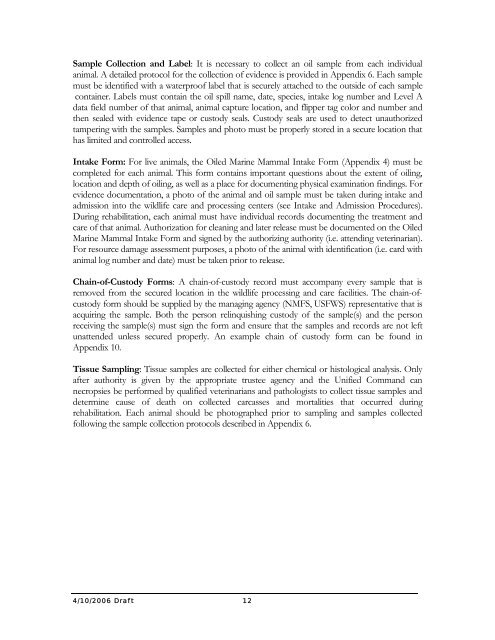Volume III, Appendices EM - National Marine Fisheries Service ...
Volume III, Appendices EM - National Marine Fisheries Service ...
Volume III, Appendices EM - National Marine Fisheries Service ...
You also want an ePaper? Increase the reach of your titles
YUMPU automatically turns print PDFs into web optimized ePapers that Google loves.
Sample Collection and Label: It is necessary to collect an oil sample from each individual<br />
animal. A detailed protocol for the collection of evidence is provided in Appendix 6. Each sample<br />
must be identified with a waterproof label that is securely attached to the outside of each sample<br />
container. Labels must contain the oil spill name, date, species, intake log number and Level A<br />
data field number of that animal, animal capture location, and flipper tag color and number and<br />
then sealed with evidence tape or custody seals. Custody seals are used to detect unauthorized<br />
tampering with the samples. Samples and photo must be properly stored in a secure location that<br />
has limited and controlled access.<br />
Intake Form: For live animals, the Oiled <strong>Marine</strong> Mammal Intake Form (Appendix 4) must be<br />
completed for each animal. This form contains important questions about the extent of oiling,<br />
location and depth of oiling, as well as a place for documenting physical examination findings. For<br />
evidence documentation, a photo of the animal and oil sample must be taken during intake and<br />
admission into the wildlife care and processing centers (see Intake and Admission Procedures).<br />
During rehabilitation, each animal must have individual records documenting the treatment and<br />
care of that animal. Authorization for cleaning and later release must be documented on the Oiled<br />
<strong>Marine</strong> Mammal Intake Form and signed by the authorizing authority (i.e. attending veterinarian).<br />
For resource damage assessment purposes, a photo of the animal with identification (i.e. card with<br />
animal log number and date) must be taken prior to release.<br />
Chain-of-Custody Forms: A chain-of-custody record must accompany every sample that is<br />
removed from the secured location in the wildlife processing and care facilities. The chain-ofcustody<br />
form should be supplied by the managing agency (NMFS, USFWS) representative that is<br />
acquiring the sample. Both the person relinquishing custody of the sample(s) and the person<br />
receiving the sample(s) must sign the form and ensure that the samples and records are not left<br />
unattended unless secured properly. An example chain of custody form can be found in<br />
Appendix 10.<br />
Tissue Sampling: Tissue samples are collected for either chemical or histological analysis. Only<br />
after authority is given by the appropriate trustee agency and the Unified Command can<br />
necropsies be performed by qualified veterinarians and pathologists to collect tissue samples and<br />
determine cause of death on collected carcasses and mortalities that occurred during<br />
rehabilitation. Each animal should be photographed prior to sampling and samples collected<br />
following the sample collection protocols described in Appendix 6.<br />
4/10/2006 Draf t 12
















